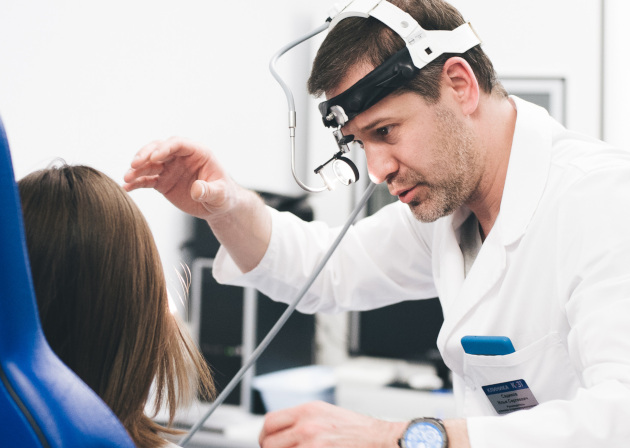Laryngeal paresis

specialists

equipment

treatment
Types of laryngeal paresis
Depending on the location of the lesions and the severity of symptoms
Depending on the location of the lesions and the severity of symptoms, doctors distinguish several types of paresis and paralysis of the larynx:
- Partial and complete - characterized by varying degrees of damage to the laryngeal muscles and the ability of the vocal cords to perform their functions
- Unilateral and bilateral laryngeal paresis - accompanied by serious breathing problems. In critical cases, urgent surgical intervention is required to ensure airway patency
Patients are also diagnosed with idiopathic paresis - sudden, unilateral paralysis of the facial nerve. To determine the type of paresis, a comprehensive diagnosis is carried out.
Depending on the causes of paresis
Depending on the causes of paresis, they are divided into myopathic, neuropathic and functional. Let's take a closer look at each of them.
Myopathic type
Characterized by damage to the laryngeal muscles themselves. The cause may be diseases such as myasthenia gravis and inflammatory myopathies (dermatomyositis, polymyositis) and genetic myopathies (muscular dystrophies). They directly affect muscle tissue, causing it to become weak or lose function.
Neuropathic type
It occurs due to damage to the part of the nervous system that is responsible for controlling the laryngeal muscles. Depending on the location of the damage, several types of paresis are distinguished:
- Peripheral - develops due to disturbances in the functioning of the vagus nerve or its branches
- Bulbar - associated with damage to the nucleus of the vagus nerve located in the brain stem
- Infectious – occurs as a complication after infectious diseases affecting the nervous system
- Cortical - appears due to disturbances in the cortical areas of the brain responsible for planning and coordinating movements of the larynx
Thanks to timely and properly selected treatment for laryngeal paresis, doctors are able to prevent the occurrence of dangerous complications.
Functional type
No physical damage to the nervous system or laryngeal muscles. It is associated with psychological factors that disrupt the normal functioning of the brain processes that regulate the functions of the larynx. Cortical and functional paresis of the larynx often occurs bilaterally.
General information about the treatment of laryngeal paresis

How is an appointment with an otolaryngologist at K+31?
Our doctors

This award is given to clinics with the highest ratings according to user ratings, a large number of requests from this site, and in the absence of critical violations.

This award is given to clinics with the highest ratings according to user ratings. It means that the place is known, loved, and definitely worth visiting.

The ProDoctors portal collected 500 thousand reviews, compiled a rating of doctors based on them and awarded the best. We are proud that our doctors are among those awarded.
Make an appointment at a convenient time on the nearest date
Price
Services






































Causes
Paresis of the larynx develops due to the following reasons:
Factors contributing to the development of paresis of the laryngeal ligaments include professional activities associated with vocal stress and inhalation of poor quality air. The disease can also occur against the background of strong emotional experiences and chronic stress.